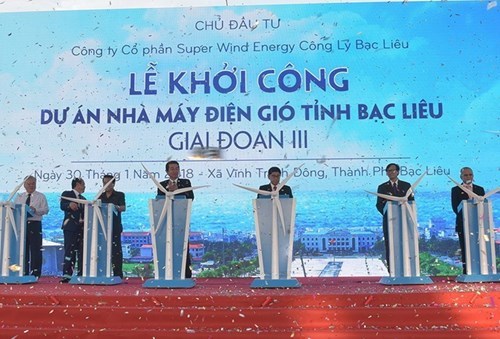This phase is part of efforts to enhance trade and investment ties between Vietnam and Thailand.
With the new turbines, the project will house a total of 133 turbines with total capacity of 241.2 MW. The third phase alone has a capacity of 142 MW.
The project is in line with the national electricity development planning during 2011-2020 with a vision towards 2030 and the Bac Lieu wind power development planning to 2020 with a vision towards 2030.
    |
 |
|
Once operational, the plant is expected to provide 373 million kWh for the national grid and generate more than 1,000 jobs. |
Speaking at the ceremony, Thailand’s Deputy Prime Minister Wissanu Kreangam congratulated Super Wind Energy Cong Ly JSC, the project’s investor, on the success of the first and second phases, expressing his hope that the third phase will be put into operation successfully.
Vice Permanent Chairman of the Bac Lieu province People’s Committee Le Minh Chien asked Super Wind Energy Cong Ly JSC and its partners to focus resources for the construction to ensure its progress and quality.
Bac Lieu promises to create the best possible conditions for the construction and operation of the project, he said.
Once operational, the plant is expected to provide 373 million kWh for the national grid and generate more than 1,000 jobs.
Vietnam has 28 coastal localities, including 14 central cities and provinces having the coastline.
Therefore, it has great potential for wind power, estimated at about 10,000 MW, according to research by the German International Cooperation Agency (GIZ).
The Ministry of Industry and Trade said that Vietnam now has only six operating wind energy mills with a total capacity of nearly 200MW.
The Government has released its National Electricity Development Plan for 2011-2020 with a strategic priority on renewable energy, with wind power capacity targeted at 800 MW by 2020 and 6,000 MW by 2030.
The country’s energy demand has increased rapidly over the last 15 years, with a commercial energy growth rate of about 9.5 percent each year. It is forecast to continue rising strongly in the next 15 years. The country’s electricity consumption demand grew about 13 percent annually from 2006 to 2010 and 11 percent each year between 2011 and 2016.
In 2015, total energy consumed nationwide was estimated at 55 million tons of oil equivalent.
Under the national energy development strategy until 2020 with a vision to 2050, Vietnam aims to produce and import 100-110 million TOEs of primary energy by 2020 and 310-320 million TOEs by 2050 so as to meet socio-economic development demand.
Source: VNA